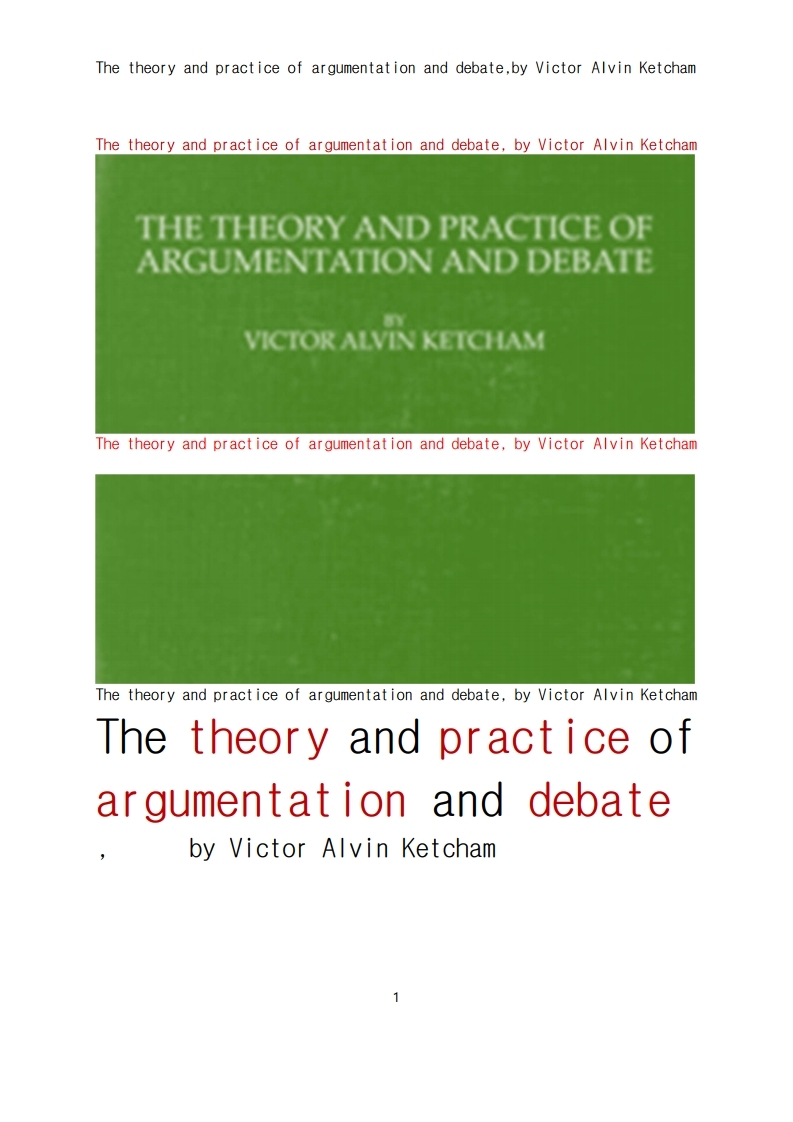CONTENTS
PART I
THE PRACTICE OF ARGUMENTATION AND DEBATE
CHAPTER I
DEFINITION AND IMPORTANCE OF ARGUMENTATION
Section Page
I. Definitions 3
II. The Object of Argumentation 5
III. Educational Importance of Argumentation 6
IV. Practical Importance of Argumentation 7
CHAPTER II
THE PROPOSITION
I. The Subject-Matter of the Proposition 9
1. The subject must be interesting 9
2. Subjects for first practice should be those of which the debater has a general knowledge 11
3. The subject must be debatable 12
II. The Wording of the Proposition 13
1. The proposition should be so narrowed as to embody only one central idea 14
2. The proposition should be stated in the affirmative 15
3. The proposition should contain no ambiguous words 16
x 4. The proposition should be worded as simply and as briefly as is consistent with the foregoing requirements 18
CHAPTER III
ANALYZING THE PROPOSITION
I. The Importance of Analysis 21
II. Essential Steps in Analysis 22
1. A broad view of the subject 22
2. The origin and history of the question 23
3. Definition of terms 24
4. Narrowing the question 27
(1) Excluding irrelevant matter 27
(2) Admitting matters not vital to the argument 28
5. Contrasting the affirmative arguments with those of the negative 29
III. The Main Issues 36
CHAPTER IV
EVIDENCE
I. Sources of Evidence 39
1. Personal knowledge 39
2. Personal interviews 40
3. Personal letters 41
4. Current literature 42
5. Standard literature 45
6. Special documents 46
(1) Reports and pamphlets issued by organizations 46
(2) Reports and documents issued by the government 48
xiII. Recording Evidence 51
1. Use small cards or sheets of paper of uniform size 53
2. Place only one fact or point on each card 53
3. Write only on one side of the card 53
4. Express the idea to be put on the card in the simplest and most direct terms 54
5. Make each card complete in itself 54
6. In recording material for refutation put an exact statement of the argument to be refuted at the top of the card 55
7. State the main issue or subject to which the evidence relates at the top of the card 55
8. State the source from which the evidence is taken at the bottom of the card 56
III. Selecting Evidence 58
1. The evidence must come from the most reliable source to which it can be traced 58
2. A person quoted as authority must be unprejudiced, in full possession of the facts, and capable of giving expert testimony on the point at issue 60
3. Evidence should be examined to determine whether there are attendant circumstances which will add to its weight 62
4. The selection of evidence must be fair and reasonable 64
5. The position and arguments of the opposition should be taken into consideration 65
6. That evidence which will appeal most strongly to those to whom the argument is to be addressed should be selected 66
IV. The Amount of Evidence Required 68
CHAPTER V
CONSTRUCTING THE BRIEF
I. The Purpose of the Brief 72
II. Method of Constructing the Brief 73
xiiIII. Rules for Constructing the Brief 76
1. A brief should be composed of three parts: Introduction, Proof, and Conclusion 76
2. Each statement in a brief should be a single complete sentence 77
3. The relation which the different statements in a brief bear to each other should be indicated by symbols and indentations 77
4. The introduction should contain the main issues together with a brief statement of the process of analysis by which they were found 79
5. The main statements in the proof should correspond to the main issues set forth in the introduction, and should read as reasons for the truth of the proposition 84
6. Every statement in the proof must read as a reason for the statement to which it is subordinate 85
7. Statements introducing refutation must state clearly the argument to be refuted 87
contents
PART II
THE THEORY OF ARGUMENTATION AN
도서소개
저자소개
목차소개





